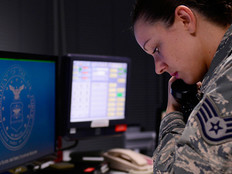Navy Cuts Costs on Software Licensing, Hopes Cloud Will Yield Further Savings
When you hear the words “U.S. Navy,” certain images might pop into your head: aircraft carriers, submarines, destroyers, fighter jets. Janice Haith wants the words “cloud computing” to be there too.
Haith, who retired last month from the Navy after serving 34 years in government, was most recently the deputy CIO of the Navy. She helped oversee how the service branch purchased, managed and used technology over the past few years, resulting in massive savings.
That trend is likely to continue as the Navy pushes more of its applications and data into the cloud, along with the rest of the Defense Department.
Squeezing Savings Out of IT
In a recent interview with Federal News Radio, Haith noted that the Navy in recent years “made some fundamental changes that overall I didn’t think we’d ever do,” such as shifting to enterprise software licenses.
Moving to an enterprise-wide model allowed the Navy to purchase software licenses from retailers at a better price, and gives the Navy better service when it upgrades software.
The Navy also altered the way it uses devices, Haith added, noting that in the past the department used to be tied to one vendor, but it is now “vendor agnostic for the most part.”
“That is a good thing,” she said. “That was another area where you saw commercial technology become part of the day-to-day fabric of what we do.”
The Navy started its software consolidation initiative in 2011, Federal News Radio notes, and at the time Haith said that the department had no idea how many of its software licenses were actually being used, when the software was purchased and by whom, and if the software was only designed for a narrow function.
Over the past three years, the Navy has saved more than $450 million on IT through these various initiatives, according to Haith.
The Navy has gotten more adept at tracking IT requirements and predicting the software it will need, Haith said. The department is also using more commercial off-the-shelf products, which pleases vendors that no longer need to make customizations for the Navy. The COTS products are working well, she said.
Shifting to the Cloud
The Navy plans to increase the amount it saves on IT by shifting to the cloud. Haith had said the Navy would release a new cloud-first strategy in February, but as yet no strategy has been announced.
“We will move as much as possible into the cloud environment for all of our applications,” she said. “As more vendors get approved by DOD, we will be using those.”
In May 2016, Department of the Navy CIO Robert Foster approved plans for the CIOs of the Navy and Marine Corps “to sign off on their own business cases for migrating to commercial cloud vendors without seeking higher-level approval as a way to reduce the red tape in getting to the cloud,” Federal News Radio reported.
More broadly, the Defense Department is taking a three-pronged approach to the cloud. It still uses traditional on-premises data centers. However, the DOD has also been embracing on-premises commercial cloud and off-premises commercial cloud services.
In November, John Hale, chief of enterprise applications at the Defense Information Systems Agency, noted that DISA’s MilCloud effort, a high-security cloud-services product portfolio that DISA manages, will incorporate commercial cloud services inside DOD data centers. According to C4ISRNET, Hale said that the Pentagon wants to make sure its data stays inside its facilities, which is a key requirement for some DOD components.
Meanwhile, Haith said the Navy expects to maintain about 10 data centers, but that as more data gets moved to the cloud — and trust in cloud computing increases across the department — that number could be reduced to as few as three.
“They will be for things that we choose not to move to a commercial provider,” she said.








